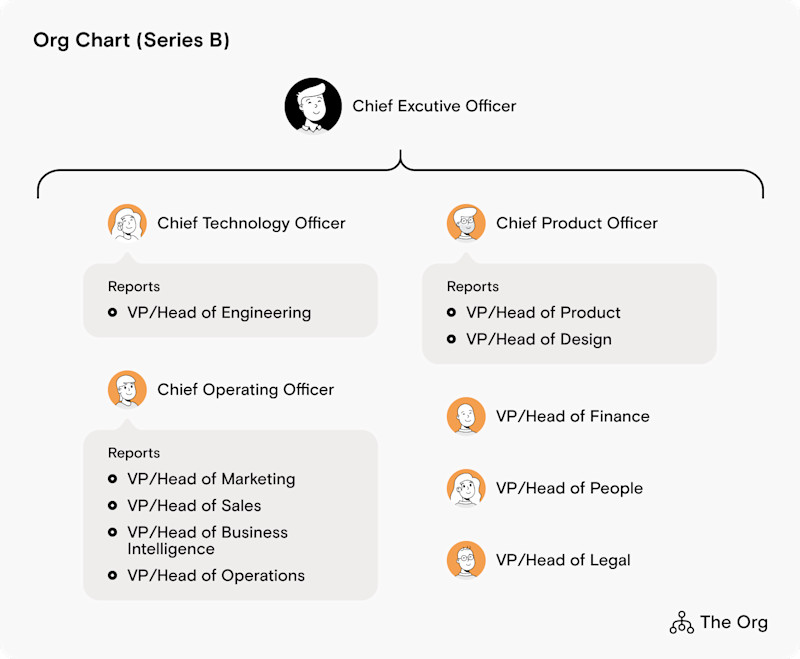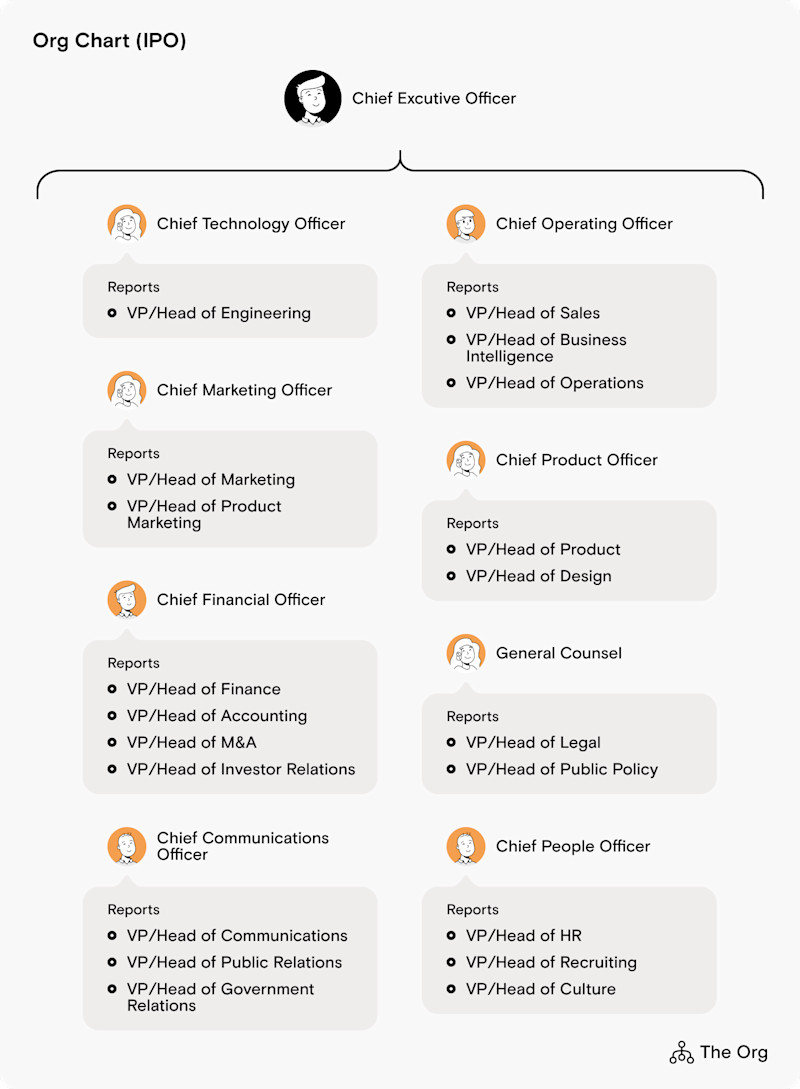- Iterate
- Organizational Structure
- The Startup Org Chart from Founding to IPO
The Startup Org Chart from Founding to IPO
Table of contents
How to build an organization for growth. Who you should hire, when, and ways to structure the team at every stage from the perspective of a repeat founder.

Founding
At the earliest stage of a startup there isn’t a need for titles or hierarchy because it’s just two people in a garage with an idea. The main question is how many co-founders you need, and who. The skills of the co-founder should supplement each other and not overlap too much to avoid tension. You need to be able to trust each other enough to make decisions separately, without creating bottlenecks. Importantly, co-founders might not be able to leave their jobs yet, and may work evenings and weekends to raise funds. What matters most is the ability to push and sacrifice to get the company ready to build on these foundations.
One Founder: A single founder is nearly always a liability, creating a single point of failure and requiring one person to wear too many hats.
Two Founders: A classic structure is a technical co-founder focused on building the product and a commercial co-founder that focuses on the product vision and can execute on the non-technical aspects of the business.
Three + Founders: More than two co-founders can be useful for breaking ties but cumbersome for making quick decisions and staying on the same page. A startup might need a third co-founder if they are in an area particularly heavy on specialized scientific knowledge or with major compliance issues.

Seed Round
At the seed stage, a company needs an internal organization that can execute on the product vision and demonstrate early growth. Other considerations are secondary, but this is essential. What matters is creating something that proves the viability of an idea, which requires the smallest and most agile team that is still capable of effectively proving whether you are onto something or not.
The company will be mostly product, engineering and design -- builders and creators -- while lighter on commercial and administrative hires. Flexibility is more important than structure so that the team can pivot rapidly and try new ideas as old ones fail. The CEO maintains all administrative tasks in addition to guiding the overall product vision, while looking for new investment.
Don't hire: Marketing Manager, Operations, or Finance -- these are roles which should be captured by the CEO or shared across the team. At this point expending unnecessary resources on marketing a product that has just begun its creation would be a mistake.

Series A Round
By the series A round, a startup will usually have a minimal viable product which has shown some early traction and proven that it has potential. At this point, the singular challenge is scaling that product and developing it as quickly as possible.
This requires more team leaders that can recruit and scale their individual functions into fully-fledged teams. The head of product executes the product vision, the head of growth attracts new customers, and the head of operations maintains the operational tasks. The administrative burdens are still limited and are still maintained primarily by the CEO.

Series B Round
A series B startup is focused on continuing its growth and driving revenue, while building a commercial and marketing arm of its business.
Growth becomes more concrete and measurable in this round and splits into separate entities like Sales, Marketing, and Product, depending on the growth strategy. Administrative overhead starts to grow, which requires hiring people to lead functions like finance, legal, and people. The organization reaches a scale where senior executives like a COO are needed to help off load the operational burdens of the CEO.
It is at this stage that the risks of administrative bloat and faulty processes become most acute. It is essential to scale equitably and to hire the necessary talent to run a larger organization. HR issues are the ones which fall by the wayside in the early stages of growth, but at this point take center-stage.

Series C and Later Rounds
After the C round, the company is in full-on scaling mode to prepare for an IPO. The company needs to start operating like a public company, which requires hiring an experienced CFO to help prepare the company for its IPO. The finance function goes from an operational necessity to a strategically important role. The size of the organization requires several new senior executives, including a Chief Product Officer and a Chief Marketing Officer.
It is at this stage that the risks of administrative bloat and faulty processes become most acute. It is essential to scale equitably, and to hire the necessary talent to run a larger organization. HR issues are the ones which fall by the wayside in the early stages of growth, but at this point they should take center-stage.

Exit (IPO, SPAC, Acquisition)
The administrative and operational requirements of a public company are much higher than for startups. Priorities turn into risk mitigation and organizations might also start looking at acquiring other companies, which increases the legal and financial overhead. Headcount also increases dramatically, requiring a Chief People Officer. Communication turns into a strategically important function and is elevated to Chief Communications Officer.

Create your own free org chart today!
Show off your great team with a public org chart. Build a culture of recognition, get more exposure, attract new customers, and highlight existing talent to attract more great talent. Click here to get started for free today.


The ORG helps
you hire great
candidates
Free to use – try today